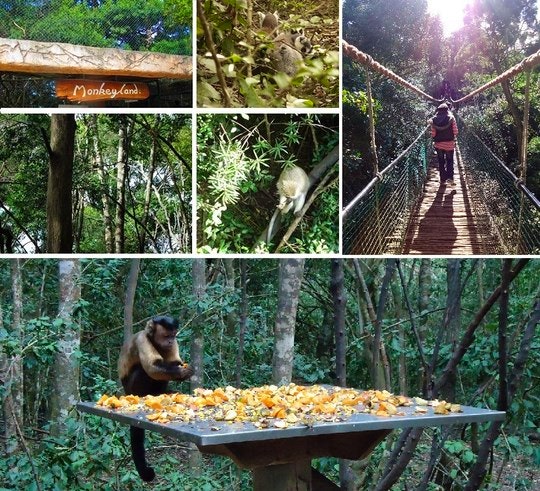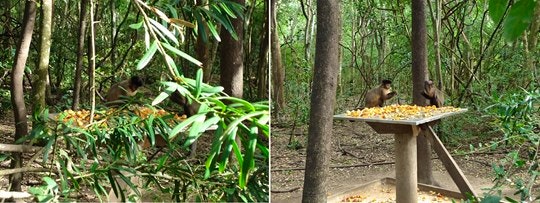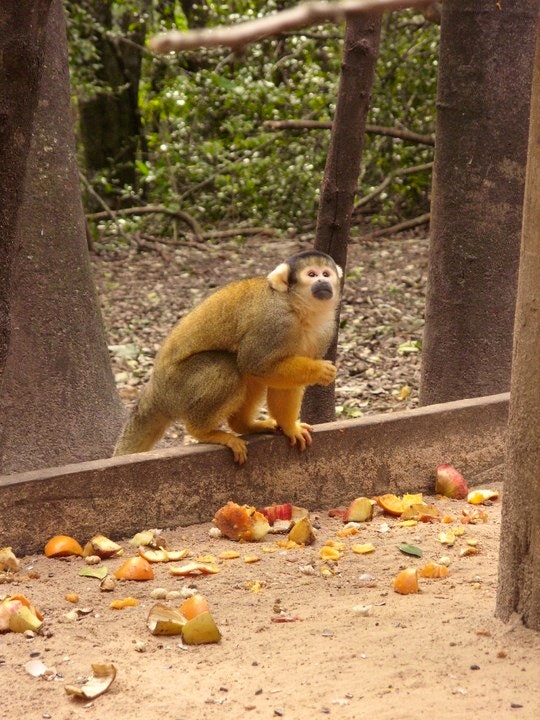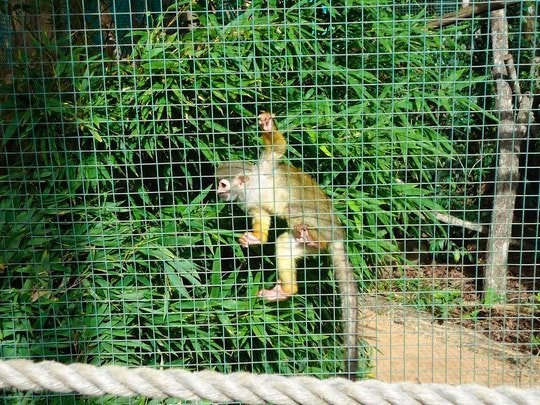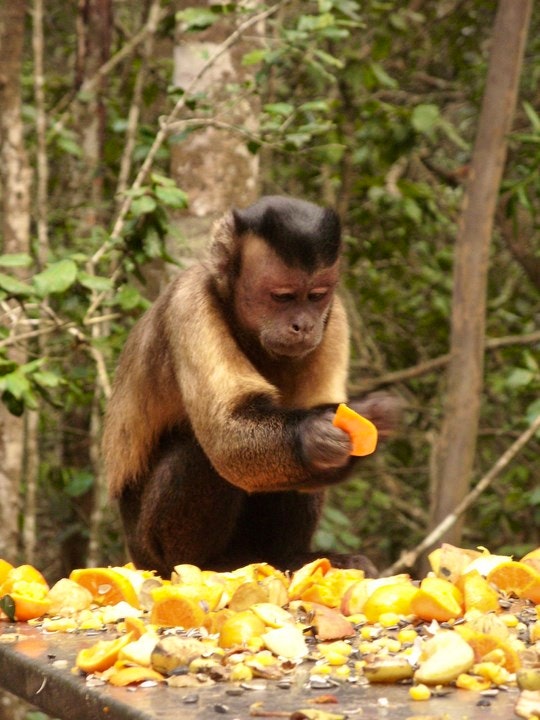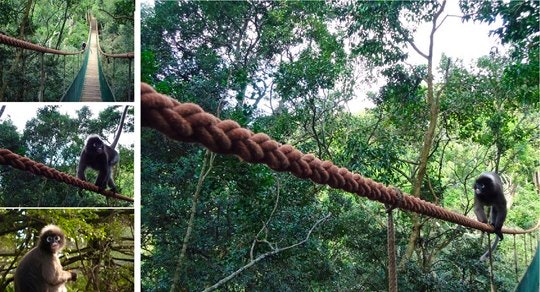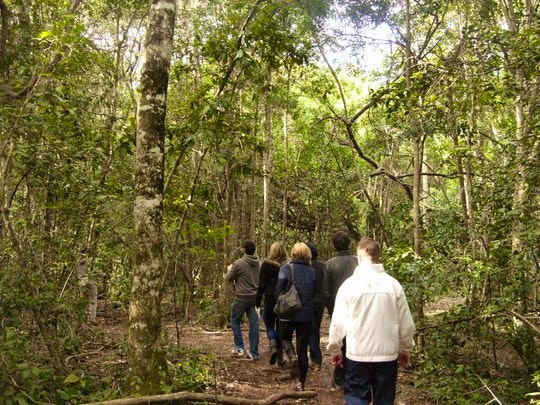A heartfelt chorus of ‘welcome to Monkeyland’ was given to us by a group of international volunteers who were waiting outdoors for our group. Though we’d been there for less than a minute, they made us feel instantly at home with their warm smiles, guiding us past stone water features and indoors to the reception area and a curio shop.
The sound of the wind whistling through the leaves of the trees, coupled with soft chirps and views of the lush forest let us swiftly realise that the largest free-roaming primate sanctuary in the world was a truly beautiful place. Monkeyland covers a 12ha forest and has 10 primate species within it, totalling around 500 monkeys. As we curiously peeked through the doorway, Vijver Jonck, a marketer, ranger, and truly passionate person bustled up to us with a smile and led us outdoors into the magical monkey forest. She chatted with us for a few minutes before heading back to work, leaving us to watch a quartet of Capuchin monkeys chattering away while feasting on fruit on an outdoor table.
Hamedi, the head ranger of Monkeyland, met us a few moments later. He was a solemn looking man at first glance, but his playful grin quickly surfaced as we started peppering him with questions about the lifestyle of monkeys, their behaviour, natural habitat, and what the life stories were of the ones before us. He didn’t hesitate as he delved into the fascinating (and sometimes sad) stories of the various primates in the sanctuary, as well as their natural behaviours, preferred dwellings, and more. It was very clear to our group that he loves his work and is passionate about the sanctuary as a whole.
Food Glorious Food
Everywhere we went, we seemed to catch monkeys feasting or sunning themselves, and Hamedi explained that the monkeys are naturally territorial – especially when food is scarce. This is why the sanctuary ensures that food is readily available to all species – so there is no need for any territorial staging and fighting for food. Also, by having the omnivorous diet (consisting of bread, chicken, fruit, etc) spread all around the sanctuary, so there is no chance of a weaker species dying out from lack of nutrition.
Rehabilitation
One of the main points which will stand out to visitors is that contrary to what you may assume, you cannot touch, pet, or play with any of the monkeys in the sanctuary. Almost all of them come from a background of being owned – and in a sense imprisoned – forced to abide by the external societal rules of humans during their formative years, and rebelling (as most species do) during their teenage years.
At the sanctuary, for the first time in their lives, they are free to make their own choices and socialize with their own kind and others, when and if they choose to. This is the ultimate goal of the rehabilitation programme – to teach them to be their natural selves. The sanctuary has a 90% success rate in this regard, and the rare 10% that are unable to revert back to their true primate selves go to a loving monkey home.
The monkeys brought in to be rehabilitated are first kept in cages for their own protection. The other monkeys of Monkeyland then take turns to visit and introduce themselves to the newcomers. Once the rangers feel the newer monkeys are socialised enough to not be in any danger, they are released from the cages to roam freely with their fellow primates.
Old World vs New World Monkeys
For those of you who’ve seen the original Pirates of the Caribbean movie (The Curse of the Black Pearl) you’ll recognise the above species as “Jack the Monkey”, Barbosas smart-as-a-whip pet. Capuchin monkeys are the most commonly used primate species in Hollywood due to their intelligence. They reach maturity at the age of 4 years, and males have a parted tuft of hair, while the females don’t. Capuchin monkeys are part of what is known as the New World monkeys.
New World, you wonder? There are two predominant types of monkeys – the Old World (African and Asian) and the New World (South American). Both are quite different with regard to agility. Most Old World monkeys use their tail for balancing and carry their babies around their tummies, while New World monkeys use their tail as an additional gripping limb and carry their babies on their backs.
Rarity
The sanctuary has only one Spectacled Langur monkey, and he’s usually as elusive as a ghost, coming out only when he wishes to. Many visitors never even catch a glimpse of him during their visit.
We were lucky enough to see him after we crossed the longest canopy suspension bridge in Africa– which swung quite a bit as we crossed it, but the beautiful views took away some of our nerves. Just as we’d reached on the other side of the bridge, Hamedi cautioned us to quieten down and turn. We then spotted the Spectacled Langur heading right for us, swinging his long tail from side to side as he made his way along the ropes of the bridge, and bee-lined for a nearby food station.
Time flew by so quickly, and there was so much to see and learn that I couldn’t condense it into just one post, so keep your eyes peeled for the continuation, with details about all of the species which inhabit Monkeyland!
Let us know if you’ve ever been to Monkeyland before, and what your thoughts of it were?

